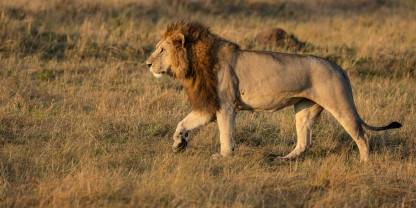- January: Good
- February: Good
- March: Fair
- April: Fair
- May: Good
- June: Excellent
- July: Excellent
- August: Excellent
- September: Excellent
- October: Excellent
- November: Fair
- December: Fair
- Excellent
- Good
- Fair
- Poor
The best time to visit Masai Mara National Reserve is during the Dry season from June to October. At this time, animals draw near to rivers and and vegetation is thinner, making wildlife easier to find and to see. During the rains (especially March, April, November and December), some driving tracks can be difficult to navigate. Your best chance to witness the spectacle of the is between July or August and October.
1,537 Masai Mara Safaris
-
Best Time
- June to October (Dry season; for general wildlife viewing) and July or August to October (For wildebeest migration)
-
High Season
- June to October and December to March (It gets very crowded except in some remote areas)
-
Low Season
- April and May (Some roads might be in bad condition and rain can sometimes interfere with your trip)
-
Best Weather
- June to October (Days are sunny, but not too hot)
-
Worst Weather
- March and April (Peak of the Wet season)
June to October Dry Season
- Although rarely hot, it is sunny and dry
- Animals gather around rivers and , making them easy to spot
- August and September are best for seeing crossing the Mara River
- Most of the park gets very crowded and good sightings tend to attract a lot of vehicles
November to May Wet Season
- The park is less busy, which makes wildlife viewing special
- The skies are clear of dust, the park is green and there are lots of flowers
- Good time to see newborn animals
- Low-season rates apply in April and May
- There are plenty of animals in the Mara, and wildlife viewing is still good
- Bird watching is excellent and are present
- Rain in March, April, November and December will sometimes interfere with your planned activities
- Roads can become tricky to travel
Wildlife Photos
Best Time To Go by Major Park
- Excellent
- Good
- Fair
- Poor
-
Amboseli National Park
- January: Excellent
- February: Excellent
- March: Good
- April: Fair
- May: Fair
- June: Excellent
- July: Excellent
- August: Excellent
- September: Excellent
- October: Excellent
- November: Fair
- December: Good
-
Buffalo Springs NR
- January: Excellent
- February: Excellent
- March: Good
- April: Fair
- May: Fair
- June: Excellent
- July: Excellent
- August: Excellent
- September: Excellent
- October: Good
- November: Fair
- December: Good
-
Lake Nakuru National Park
- January: Excellent
- February: Excellent
- March: Good
- April: Fair
- May: Fair
- June: Excellent
- July: Excellent
- August: Excellent
- September: Excellent
- October: Excellent
- November: Excellent
- December: Excellent
-
Masai Mara NR
- January: Good
- February: Good
- March: Fair
- April: Fair
- May: Good
- June: Excellent
- July: Excellent
- August: Excellent
- September: Excellent
- October: Excellent
- November: Fair
- December: Fair
-
Samburu National Reserve
- January: Excellent
- February: Excellent
- March: Good
- April: Fair
- May: Fair
- June: Excellent
- July: Excellent
- August: Excellent
- September: Excellent
- October: Good
- November: Fair
- December: Good
-
Tsavo East National Park
- January: Excellent
- February: Excellent
- March: Good
- April: Fair
- May: Fair
- June: Excellent
- July: Excellent
- August: Excellent
- September: Excellent
- October: Excellent
- November: Fair
- December: Good
-
Tsavo West National Park
- January: Excellent
- February: Excellent
- March: Good
- April: Fair
- May: Fair
- June: Excellent
- July: Excellent
- August: Excellent
- September: Excellent
- October: Excellent
- November: Fair
- December: Good



